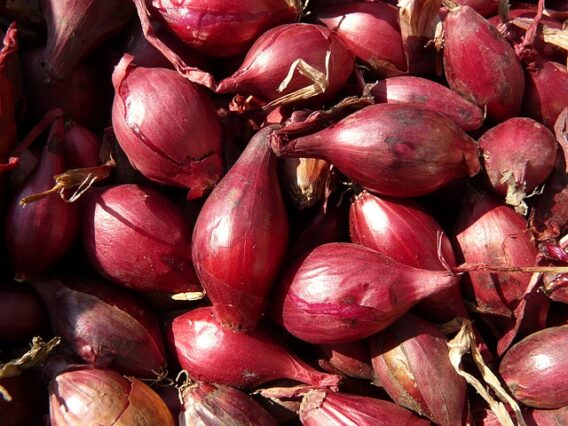Shallots have a flavour that is sweeter than an onion, they are delicious in lots of dishes and very good in pickles and chutney. They are easy to grow, and once planted, you can just leave them to it.

Shallots are usually bought as sets, which are small bulbs. You can also grow shallots from seed, although it will take longer for the crop to mature.
Seeds are cheaper than sets, but they do require more time and effort to grow. As they grow, shallot sets form a ring of bulbs, whereas shallots grown from seed will only produce a single bulb. Another benefit of sets is that they are also more resistant to disease.
You can buy quality shallot sets from Thompson and Morgan.
Planting Shallots
Shallot sets can be planted from November to March, although tradition has it that shallots should be planted on the shortest day in mid-December, and be harvested on the longest day in summer.
Shallots prefer a sunny, well-drained position. They can be planted in rows and each plant spaced approximately 15 inches apart. The rows should be spaced about 20 inches apart. This will allow the shallots plenty of room to grow.
Push each set into the soil so that the top quarter of the bulb is visible. Gently firm the soil. Frost, rain and birds can disturb the soil and lift the sets out. Check regularly to make sure the sets stay in place until they begin to root and grow.
Sowing Shallots from Seed
Sow shallot seeds in modules or pots, undercover in late winter, and then harden them off before planting outside in spring. Or, you can sow outside in early spring. As they grow, you will need to thin them out to make room for the strongest seedlings.
Because only one bulb is produced, shallots from seed can be planted closer together.
Caring for Shallots
Remove any weeds that grow between your plants and rows.
Shallots do not require much water, and soil that is too wet can cause the bulbs to rot. Water only in hot weather.
Harvesting Shallots
Shallots are usually ready to harvest in July to August, when the foliage begins to turn yellow. Carefully lift the bulbs with a fork and separate.
Leave them for a few days to dry in a well-ventilated area. You can then remove the foliage and any outer skin that is flaking.
Shallots are really good for storage and, once dry, can be stored for months in a cool place.

